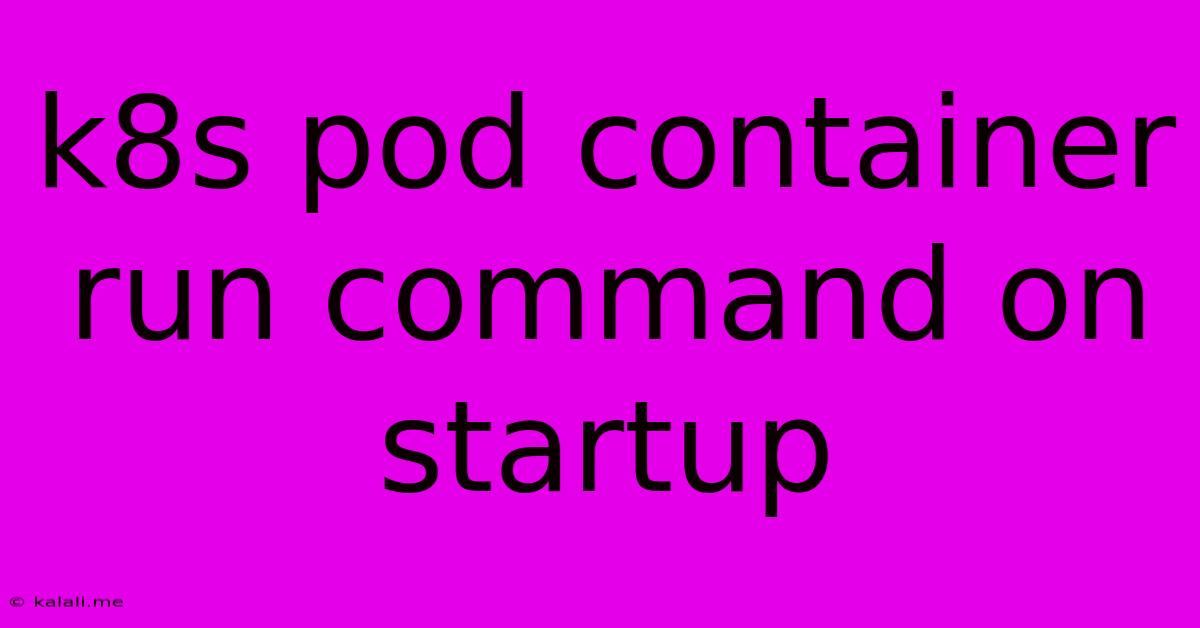K8s Pod Container Run Command On Startup
Kalali
May 29, 2025 · 3 min read

Table of Contents
Running Commands in Your Kubernetes Pod Containers on Startup
Kubernetes Pods are the fundamental units of deployment in a Kubernetes cluster. Understanding how to execute commands within your Pod's containers at startup is crucial for setting up applications correctly and managing their lifecycle. This article will guide you through various methods for running commands in your Kubernetes Pod containers during startup, encompassing best practices and potential pitfalls. We'll cover using command and args in your container definition, and exploring init containers for more complex scenarios.
Why Run Commands on Startup?
Running commands on startup is essential for various reasons:
- Application Initialization: Many applications require specific setup steps before they can function correctly. This might involve creating directories, downloading configuration files, or initializing databases.
- Environment Setup: You might need to set environment variables or configure network settings within the container before your main application starts.
- Dependency Management: Some applications rely on external services or dependencies that need to be checked or configured before the application can begin operations.
Methods for Running Startup Commands
There are two primary approaches to executing commands during Pod startup:
1. Using command and args in your Container Definition
This is the simplest method and suitable for many common use cases. You define the command and arguments directly within your container specification in the Kubernetes YAML file.
Let's illustrate this with an example. Suppose you have a simple Node.js application and you want to create a directory before starting the application:
apiVersion: v1
kind: Pod
metadata:
name: my-node-app
spec:
containers:
- name: my-node-container
image: my-node-image:latest
command: ["sh", "-c"]
args:
- |
mkdir -p /app/data
node app.js
In this example, the command is set to ["sh", "-c"], allowing us to execute shell commands. The args field contains the commands to create the /app/data directory and then start the Node.js application using node app.js. This ensures the directory exists before the main application starts.
Important Considerations:
- Error Handling: If a command in the
argsfield fails, the entire container startup will fail. Implement robust error handling within your startup scripts. - Simplicity: This approach is best for straightforward commands. Complex initialization processes should be handled differently, using init containers (discussed below).
- Security: Be mindful of security implications when executing shell commands. Avoid using untrusted or unvalidated inputs.
2. Using Init Containers for Complex Initialization
Init containers are designed specifically for complex setup tasks. They run before the main application containers, ensuring the environment is properly prepared. They’re particularly useful for scenarios requiring multiple steps or external dependencies.
Here's how you might use init containers to download a configuration file before starting your application:
apiVersion: v1
kind: Pod
metadata:
name: my-app
spec:
initContainers:
- name: download-config
image: busybox
command: ["sh", "-c"]
args:
- |
wget https://example.com/config.json -O /app/config.json
containers:
- name: my-app-container
image: my-app-image:latest
volumeMounts:
- name: config-volume
mountPath: /app
env:
- name: CONFIG_PATH
value: /app/config.json
volumes:
- name: config-volume
emptyDir: {}
In this example, the download-config init container uses wget to download the configuration file before the main my-app-container starts. The main container then uses the downloaded configuration. This approach offers better separation of concerns and improves the reliability of your application startup.
Choosing the Right Method:
- Use
commandandargsfor simple, single-step initialization. - Use init containers for complex setup, dependency management, and scenarios requiring multiple steps or external dependencies.
By understanding these techniques, you can effectively manage the startup process of your Kubernetes Pods, ensuring your applications are deployed and configured correctly, improving the overall reliability and maintainability of your Kubernetes deployments. Remember to always prioritize security and error handling in your startup scripts.
Latest Posts
Latest Posts
-
One Punch Man Manga Online Free
May 31, 2025
-
Is There A Lag On Airpods Gaming Pc
May 31, 2025
-
What Is Circumcision In The Bible
May 31, 2025
-
How To Use My Laptop As A Monitor
May 31, 2025
-
What Is A 2 Way Mirror
May 31, 2025
Related Post
Thank you for visiting our website which covers about K8s Pod Container Run Command On Startup . We hope the information provided has been useful to you. Feel free to contact us if you have any questions or need further assistance. See you next time and don't miss to bookmark.